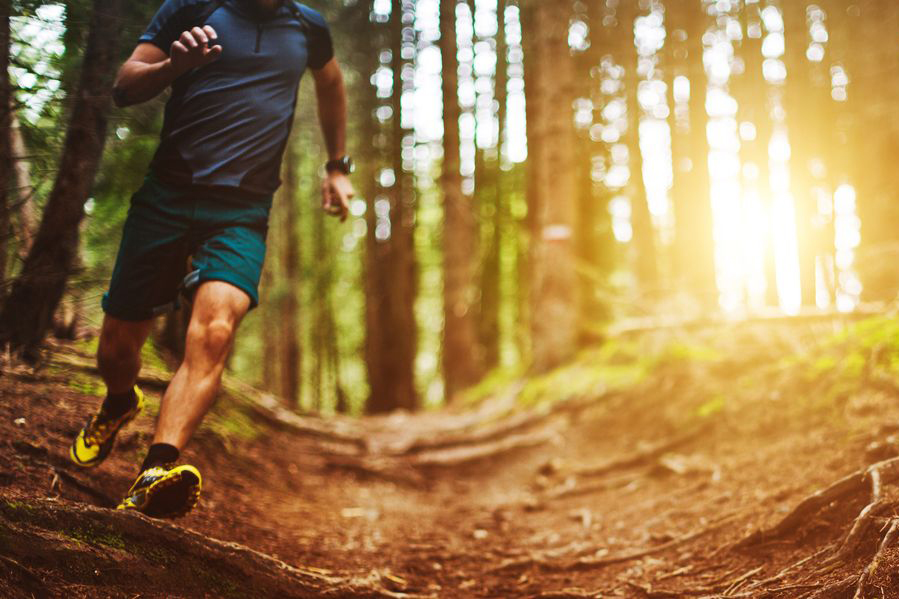Oh, the Irony…
Just before sitting down to write this blog, I jammed an ice pack inside of a compression sock and slid it over my right leg. Because earlier this week I managed to strain my calf. While running. On trails.
I’ll wait right here while you double check the title of this article.
And now that you are back, this is the point where you ask me “If running trails is so important for injury prevention, why is it that you just injured yourself while running trails?” Valid question. So here is my answer: I had not been running them enough.
My family and I spent this past summer in Wichita, KS for some Air Force training. And while Coastal Carolina is flat, Kansas is flatter. At home, I have mapped out some go-to “hills” and trails to incorporate into my run plan. I had no such luck in Kansas. Aside from some occasional dirt and crushed gravel, all of which was still very flat, I logged hundreds of repetitive miles that offered little to no variation. Some physiological structures got stronger while others got weaker. And after a week of big, fatiguing volume back home, one of those weaknesses came to the surface this past Tuesday on the trail. Luckily, it is minor, and I will be back at it in no time. But it reminded me, now more than ever, that if I am going to be putting a lot of running stress on my body, spending more time on the trails is critical! And here are the reasons why:
Reason #1: Trail Running Adds Variation
As mentioned above, running straight, flat, repetitive surfaces can result in imbalances as we overload certain body groups and underutilize others. While adding in hills or changing pace can help distribute stress to other areas, many of our stabilizers remain dormant. And just as a muscle in a cast atrophies from not being used, the same can happen with portions of our support structure. These imbalances create injury vulnerabilities as they are not able to fully support when called upon, which I believe is precisely what happened to me earlier this week.
Trails help fill in the blanks. With uneven terrain, frequent turns and elevation changes, and even mini obstacles like roots and rocks, our stabilizers and core come alive to fully support us. Don’t believe me? Just give it a shot. If you haven’t hit the trails recently (or ever), your body will give you clear feedback the next day about what muscles / connective tissue had not been used in a while. The trail’s ability to fill those gaps will build you into a much more resilient runner if you take advantage of it on a regular basis.
Reason #2: Trails Are Perfect for Recovery
Having run plenty of roads, I know firsthand that there are 2 major pitfalls when attempting a recovery run on the pavement. The first is that the surface itself can be hard on the body, reducing the effectiveness of the intended recovery. And the second? I can never seem to slow my butt down enough to make it a REAL recovery run! Don’t lie. You’ve been there. I have seen too many “Easy Run” Strava posts with heart rates in the 170s.
Trails help in both areas. To start, trail surfaces are typically softer. This leads to reduced foot strike forces which is already a big win. But when you also consider that most runners also shorten their stride on a trail due to uneven terrain, the overall reduction of impact stress is a game changer. A shortened stride usually allows our foot to land directly beneath our body, resulting in better overall alignment. And if you are someone who tends to overstride on the pavement, this can improve your form as well. I am not saying that trail running will always feel easy on your body, but compared to bounding down your neighborhood street, your suspension system will likely be much happier.
Trails are also good at slowing you down. It is easier to not fret over pace because most trails demand an easy-going flow to successfully navigate them. I find myself much more in tune with my body, easing into turns and gently adjusting speed as appropriate, because a trail rewards a certain amount of finesse. It’s kind of like trying to drive in rush hour traffic. If you are in a hurry, it is going to be a lot of laying on the gas and then slamming on the breaks. But if you have patience and go with the flow, you may cruise along easily at a comfortable, relaxed pace. And that is right where you want to live during a recovery run. The better you can recover, the less susceptible you will be to future injury.
Reason #3: It Can Help Reduce Mental Stress
Nature has a way of reminding us that the world is much bigger than the stressful situations we often find ourselves in. Along with the benefits listed above, trails will nurture your soul if you allow them to. There is a unique healing that takes place when connecting with the great outdoors that is difficult to replicate in other parts of societal living. According to a 2019 article in Women’s Running, “Research shows that spending time in nature can reduce anxiety, relieve stress and even make you more satisfied with life in general—no small perk.” Amen to that! So, while running in general is already a positive method for coping with stress, trail running specifically may offer a more effective experience for stepping into the most carefree version of yourself. And with reduced stress comes increased recovery, once again better protecting you against potential injury.
I Would Love to Hear from You
I sincerely hope that you found value in this article and that I was able to communicate the benefits of including trails in your training, especially for injury prevention. And don’t worry about me. I will be just fine. Feeling better already!
Have questions? Or your own trail running story you would like to share?
Hit me up on Instagram at @Go_Be_Awesome or send an email to theultrarunningguys@gmail.com. Also be sure to check out theultrarunningguys.com for more content!


